
Nek Chand was a self-taught Indian artist who died at the age of 90 in June of 2015. In tribute to Chand, the Rubin Museum of Art is now displaying two of his Fantasy Garden sculptures in the lobby.
Ten of Chand’s dynamic sculptures were donated to the Rubin Museum of Art in 2014 and were originally created for a site specific installation at the National Children’s Museum in Maryland in 1984. Unlike many of our Tibetan and Nepalese bronze sculptures, these pieces were created to exist outdoors in a public space or “Fantasy Garden” amongst many other representations of figures and animals. They were originally installed outside by Chand and a team of volunteers in a setting that would have been like a mini version of his famous Rock Garden in Chandigarh, India containing over two thousand figures and animals.
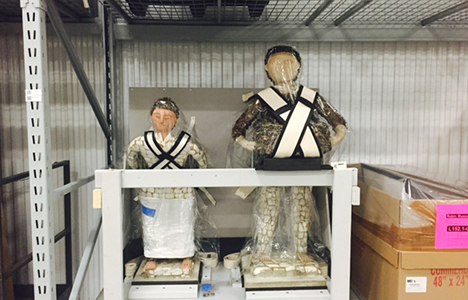
The materials used to decorate these pieces are a combination of ceramic crockery shards, volcanic rock, shell and glass that were applied into wet concrete over a metal support such as rebar. Multiple losses in decoration and stress cracking in various places are evidence that the sculptures have existed outside for thirty years. While inherently resilient, all material becomes vulnerable over time due to moisture and extreme climate fluctuation, hence the loss of adhesion in the concrete. The goal for rehousing these sculptures into the Rubin Museum’s collection is to minimize further deterioration and material loss as well as to provide proper support when moving the objects via art shuttle to and from the museum and off-site storage facility.
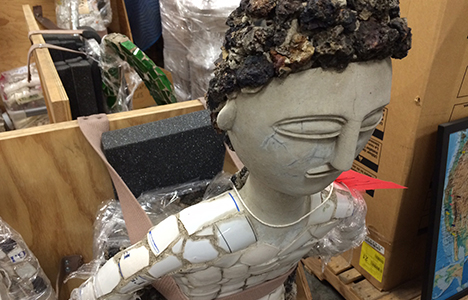
In order to begin the process of entry into the collection, Rubin Collections Management staff needed early access to the artworks which were being kept in a commercial warehouse outside of Baltimore. During a site visit to the warehouse the objects that were selected to be donated to the Rubin needed to be isolated from the larger group of Nek Chand pieces being stored there. Modified shipping pallets found on location were repurposed to accommodate our group of figures and animals which were then securely packed for temporary storage and staging for later transportation to the Museum’s off-site storage facility. There would be ample space to repack everything there with long term considerations in mind. Initial condition evaluations and measurements were also recorded at this time to help determine the next steps for conservation and rehousing.
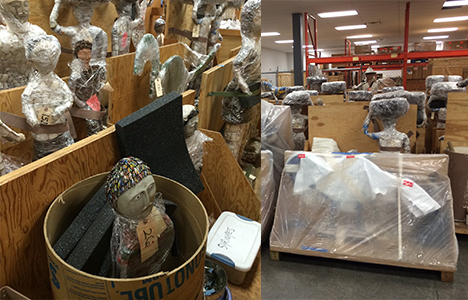
An art transportation company came to collect the packed pallets and added some additional braces and padding for the 192 mile trip to New York. Once the objects arrived we could readily see the negative results that movement and vibration had on the material. It was necessary to call in contract conservators specializing in object treatment to reattach some of the loose pieces and help consolidate areas that would be prone to future damage.
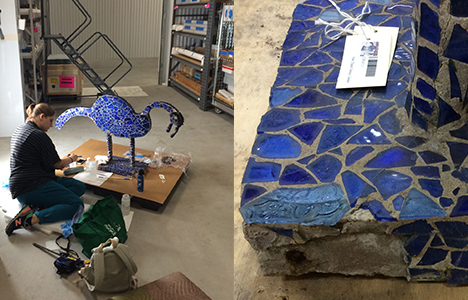
This initial journey showed that the objects were held firm inside the pallets but did not protect well enough against shock. This is where inert polyethylene foam came in to help the situation! By custom fitting archival foam to specific void spaces, this material can do double duty by absorbing vibration and also provide a firm yet cushioned support for the art. The solid wood pallet skids were also not helping the negative vibration problem. For this we employed heavy-duty plastic skids that provide resilient cushioning, the equivalent of three inches of urethane foam. As an added bonus, the skids also resist friction when slid over irregular surfaces such as truck floors and pallet rack shelving. Finally, as a non-abrasive barrier between the foam and the textured objects, nylon film was used to wrap the art and act as a transparent dust covering & waterproof membrane for the objects. These materials, in combination with cotton webbing secured in key areas of weakness, will do a much better job in creating a softer ride and a safer storage solution in our collection for many years to come.
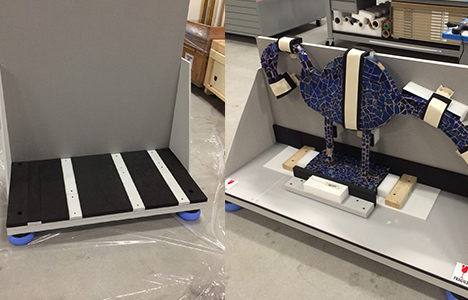
But that’s not the end of the story – two of the larger Nek Chand sculptures have been installed in the museum’s windowed lobby this month. This meant that display designs had to be worked out, exhibition furniture and mounts needed to be fabricated, signage written and printed, high resolution images professionally shot, and shipping and installation for the objects coordinated (time to test out the new packing arrangement!). Gladly, everything went smoothly, including a very safe journey across the East River for the objects.
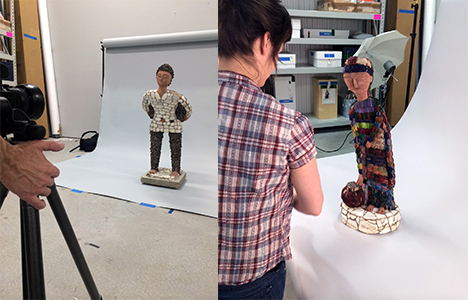
Lots of activity from so many departments with a unified mission made it possible for the newly donated Nek Chand sculptures to be seen from both inside and outside at the Rubin Museum of Art. Now we are sharing these pieces, part of Chand’s legacy, with the world.
You can see Nek Chand’s sculptures Boy with Back Basket, Ceramic Shirt, Clinker Legs and Blue Glass Animal on display in the lobby at the Rubin Museum through January 2016.

